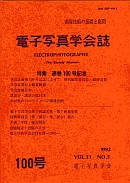Volume 34, Issue 1
Displaying 1-13 of 13 articles from this issue
- |<
- <
- 1
- >
- >|
Original Articles: comprehensive paper
-
1995Volume 34Issue 1 Pages 3-22
Published: 1995
Released on J-STAGE: April 06, 2007
Download PDF (3030K)
Original Articles: regular paper
-
1995Volume 34Issue 1 Pages 23-29
Published: 1995
Released on J-STAGE: April 06, 2007
Download PDF (2134K)
Imaging Today
“Future Technologies from Old Knowleges &mdash Part II —”
“Future Technologies from Old Knowleges &mdash Part II —”
-
1995Volume 34Issue 1 Pages 31-35
Published: 1995
Released on J-STAGE: April 06, 2007
Download PDF (674K) -
1995Volume 34Issue 1 Pages 36-37
Published: 1995
Released on J-STAGE: April 06, 2007
Download PDF (588K) -
1995Volume 34Issue 1 Pages 38-39
Published: 1995
Released on J-STAGE: April 06, 2007
Download PDF (626K) -
1995Volume 34Issue 1 Pages 40-41
Published: 1995
Released on J-STAGE: April 06, 2007
Download PDF (799K) -
1995Volume 34Issue 1 Pages 42-43
Published: 1995
Released on J-STAGE: April 06, 2007
Download PDF (568K) -
1995Volume 34Issue 1 Pages 44-45
Published: 1995
Released on J-STAGE: April 06, 2007
Download PDF (553K) -
1995Volume 34Issue 1 Pages 46-47
Published: 1995
Released on J-STAGE: April 06, 2007
Download PDF (609K) -
1995Volume 34Issue 1 Pages 48-49
Published: 1995
Released on J-STAGE: April 06, 2007
Download PDF (589K) -
1995Volume 34Issue 1 Pages 50-51
Published: 1995
Released on J-STAGE: April 06, 2007
Download PDF (635K) -
1995Volume 34Issue 1 Pages 52-53
Published: 1995
Released on J-STAGE: April 06, 2007
Download PDF (623K) -
1995Volume 34Issue 1 Pages 54-55
Published: 1995
Released on J-STAGE: April 06, 2007
Download PDF (580K)
- |<
- <
- 1
- >
- >|
